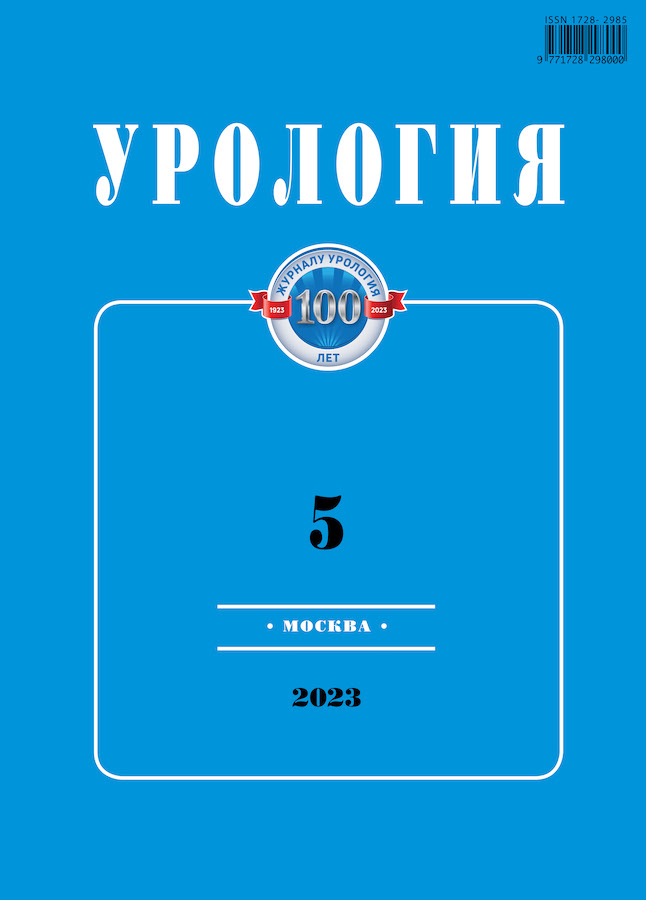Express analysis of lithogenic substances in a single urine portion normalized by urine creatinine: the degree of diagnostic reliability
- Autores: Juraga T.M.1, Gres A.A.1, Kukhta T.S.2, Gres N.A.1, Gaponenko A.D.1
-
Afiliações:
- Belarusian Medical Academy of Postgraduate Education
- The State Scientific Institution «The United Institute of Informatics Problems of the National Academy of Sciences of Belarus»
- Edição: Nº 5 (2023)
- Páginas: 28-32
- Seção: Original Articles
- ##submission.datePublished##: 30.12.2023
- URL: https://journals.eco-vector.com/1728-2985/article/view/625312
- DOI: https://doi.org/10.18565/urology.2023.5.28-32
- ID: 625312
Citar
Texto integral
Resumo
Objective: The aim of the study is to study the diagnostic possibilities of determining the excretion of stone-forming substances in the morning portion of urine, normalized by the level of urinary creatinine, as an express analysis of lithogenesis activity in patients with urolithiasis (UCD).
An object, materials, methods: Tocreate reference values of the «lithogenic substance/creatinine» indicator, two cohorts were formed: children 7–17 years old (n=364) of health group I-II (m:d=1:1,3) and adults (n=239) 18-59 years old (m:w=1:1,5) with chronic non-infectious pathology in compensated form (grade I-II hypertension, chronic gastroduodenitis, food allergy). Clinical approbation of the method was performed in patients with ICD (n=441) 45,7±14,9 years and in the comparison group (n=123) 40,2±11,4 years without diagnostic signs of urological pathology and metabolic syndrome. Determination of the concentration in the urine of Ca, P, Mg, uric acid (UA), oxalates (Ox), creatinine (Cr) was performed using commercial kits «Vital-Diagnostics SPb» (Russia), «Сormay» (Poland) on an automatic clinical analyzer DIALAB (Austria). Statistical data processing was carried out using the Statistica program (version 8.0) and ROC analysis.
Results: In the study of a single morning portion of urine, the violation of its metastability was judged by the «lithogenic substance/creatinine index», which is the concentration (mmol/l) in the biosubstrate of the substances responsible for the process of lithogenesis (Ca, P, Mg, UA, Ox), normalized by creatinine urine (Cr, mmol/l) and expressed in relative units. Developed by us in the age-sex aspect (7–10; 11–17 and >17 years), its reference indicators statistically significantly (p<0,05) decrease with age, having lower values in women compared to men. During clinical approbation of the method in patients with KSD, a significant (p<0,05) excess of the median values of the «lithogenic substance / creatinine» index for Ca, Mg, Ox, UA was revealed in comparison with the corresponding indicators in the comparison group. According to the ROC-analysis using the index differentiation scale, various degrees of diagnostic reliability of the tests were obtained: «Са/Cr» and «Ох/Cr» correspond to «acceptable information content» (DS – 72% and 71%; AUC – 0,72 and 0,73) with «extremely weak information content» of the P/Cr index (DS – 49%, AUC – 0,52).
Conclusion. As an alternative/supplement to the determination of urinary daily excretion of lithogenic substances, the method of studying the excretion of stone-forming substances (Ca, Mg, P, Ox, UA ions) normalized by urine creatinine level in a single urine portion can be recommended as an express analysis to identify the emerging lithogenic syndrome.
Palavras-chave
Texto integral
Sobre autores
T. Juraga
Belarusian Medical Academy of Postgraduate Education
Email: 2652441@mail.ru
Senior fellow at the research laboratory
Belarus, MinskA. Gres
Belarusian Medical Academy of Postgraduate Education
Autor responsável pela correspondência
Email: n_gres@mail.ru
M.D., Professor of urology and nephrology department
Belarus, MinskT. Kukhta
The State Scientific Institution «The United Institute of Informatics Problems of the National Academy of Sciences of Belarus»
Email: tatianakuhta@tut.by
Researcher at the Bioinformatics Laboratory
Belarus, MinskN. Gres
Belarusian Medical Academy of Postgraduate Education
Email: n_gres@mail.ru
Candidate of medical sciences, associate professor, docent, leading scientific member of scientific-research laboratory
Belarus, MinskA.D. Gaponenko
Belarusian Medical Academy of Postgraduate Education
Email: dr.haponenka@gmail.com
Senior Lecturer, Department of Urology and Nephrology
Belarus, MinskBibliografia
- Turk C., Knoll T. et al EAU Guidelines on urolithiasis. European Association of Urology. 2015; 97 p.
- Lyalikov S.A, Sukalo A.V., Kuznetsov O.E. Centile characteristics of anthropometric and laboratory parameters in children in the modern period. Instructions for use. Minsk, 2009, 21 p. Belarus. (Ляликов С.А, Сукало А.В., Кузнецов О.Е. Центильные характеристики антропометрических и лабораторных показателей у детей в современный период. Инструкция по применению. Минск, 2009, 21 с.)
- Laboratory clinical technologies. Requirements for the quality of clinical laboratory research. Part 3. Rules for assessing the clinical informativeness of laboratory tests. GOSTR 53022.3-2008. Russian (Технологии лабораторные клинические. Требования к качеству клинических лабораторных исследований. Часть 3. Правила оценки клинической информативности лабораторных тестов. ГОСТР 53022.3-2008).
- Korolyuk I.P. Medical Informatics: уextbook − 2nd ed., reprint. and add. − Samara: LLC «Etching»: GBOUVPO «SamGMU». 2012. 244 p. Russian (Королюк И.П. Медицинская информатика: учебник/ − 2 изд., перераб. и доп. − Самара: ООО «Офорт»: ГБОУВПО «СамГМУ». 2012. 244 с.)
- Fletcher R., Fletcher S., Wagner E. Clinical epidemiology. Fundamentals of evidence−based medicine. − M.: MediaSphere, 1998. 352 p. Russian (Флетчер Р., Флетчер С., Вагнер Э. Клиническая эпидемиология. Основы доказательной медицины. − М.: МедиаСфера, 1998. 352 с.).
- Straub М., Strohmaier W.L., Berg W., B Beck, Hoppe B., Laube N., Lahme S., Schmidt M., Hesse A., Koehrmann K.U. Diagnosis and metaphylaxis of stone disease. Consensus concept of the National Working Committee on Stone Disease for the upcoming German Urolithiasis Guideline. World J Urol. 2005;23(5):309–323.
- Spivacow F.R., Del Valle E.E., Lores E., Rey P.G. Kidney stones: composition, frequency and relation to metabolic diagnosis Medicina (B Aires). 2016;76(6):343–348.
- Sargent J.D., Stukel T.A., Kresel J., Klein R.Z. Normal values for random urinary calcium to creatinine ratios in infancy. J Pediatr. 1993;123(3):393–397. doi: 10.1016/s0022-3476(05)81738-x.
- Tic N.U. Clinical guide to laboratory tests. / Tic N.U.[et al.]; under the general ed. Titsa N.U. M.: ENAMED-press. 2003; 942p. Russian (Тиц Н.У. Клиническое руководство по лабораторным тестам. / Тиц Н.У. [и др.]; под общ. ред. Тица Н.У. М.: ЭНИМЕД-пресс. 2003; 942 с.).
Arquivos suplementares









